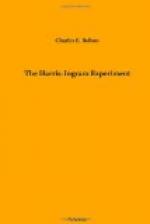That M. Worth possessed rare artistic taste aside from dressmaking is evidenced in the beauty of his rural home at Suresnes on the Seine, seven and a half miles from Paris. It is a superb work of harmony and is like a charming mosaic, every piece fitting into every other piece. He was his own architect, designer, upholsterer, and gardener. His villa lies beneath Mt. Valerien, one of the finest sites near Paris, and the outlook on the Seine, the Bois de Boulogne, and Paris, is a dream of beauty.
Hurriedly passing down the Rue de la Paix, the stately Column Vendome in the vista, the Harris party entered M. Worth’s establishment, to which women, from actress to empress, make pilgrimages from the end of the world.
What a medley of people were already assembled! English duchesses, Russian princesses, Austrians, Spanish and Levantine aristocracy; wives and daughters of American railroad kings, of oil magnates, and of coal barons; brunette beauties from India, Japan, South America, and even fair Australians, all unconsciously assuming an air of ecstasy as they revelled in the fabric and fashion of dress; and stalking among them, that presiding genius, M. Worth, who in his mitre-shaped cap of black velvet, and half mantle or robe, strikingly resembled the great painter Hogarth.
Mrs. Harris sent forward her letter of introduction from her husband’s New York banker, and soon she and her friends were ushered into the presence of M. Worth himself. He seemed very gracious, asking about several good friends of his in America, and added, “Americans are my best clients, though we dispatch dresses to all parts of the world.”
Gertrude inquired as to the origin of fashion. M. Worth answered cautiously, “When new fabrics or designs of material are invented, some require a severe style, and some are adapted for draperies, puffings, etc., and then the stage has great influence over fashion.”
May Ingram said, “Mr. Worth, how do you arrange designs?” He answered, “All my models are first made in black and white muslin, and then copied in the material and coloring which I select. In a studio our models are photographed for future reference.”
Saying this, he excused himself to welcome new arrivals, first having placed the Harrises in charge of a competent assistant. M. Worth’s many rooms were plainly furnished with counters for measuring materials. The floors were covered with a gray and black carpet, in imitation of a tiger’s skin, with a scarlet border. Several young women dressed in the latest style of morning, visiting, dinner, and reception toilets, passed up and down before clients to enable them to judge of effects. Mrs. Harris explained that one daughter desired, at an early date, a wedding dress and that the other members of her party wanted gowns.
Friday and Saturday were occupied at Worth’s in selecting dresses, and elsewhere in search of gloves and other essentials. A delightful hour was spent among the many makers of artificial flowers. Skilled fingers make from wire and silk stems and stamens and dies, shape leaves and petals which are darkened by a camel’s hair pencil, or lightened by a drop of water. Capable botanists and chemists are employed, and nature herself is rivaled in delicate construction and fragrance even.




